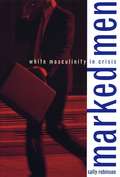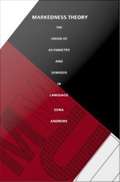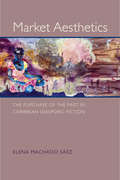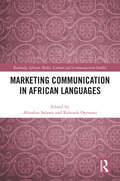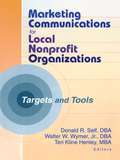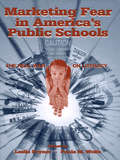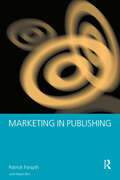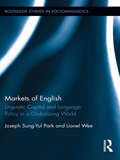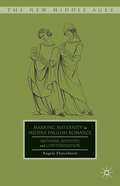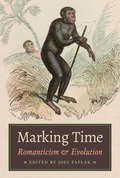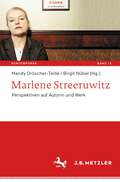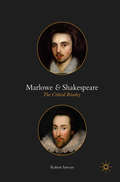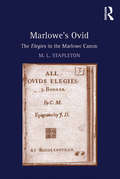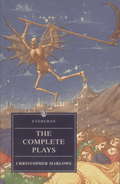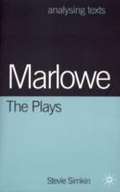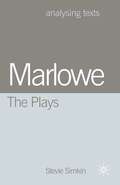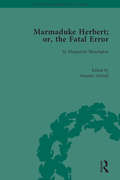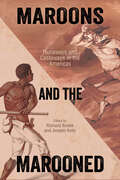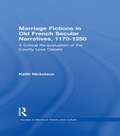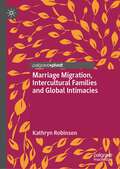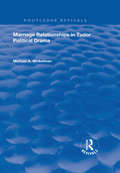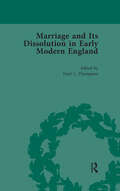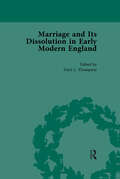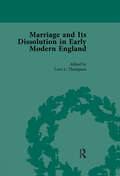- Table View
- List View
Marked Men: White Masculinity in Crisis
by Sally RobinsonWhite men still hold most of the political and economic cards in the United States; yet stories about wounded and traumatized men dominate popular culture. Why are white men jumping on the victim bandwagon? Examining novels by Philip Roth, John Updike, James Dickey, John Irving, and Pat Conroy and such films as Deliverance, Misery, and Dead Poets Society—as well as other writings, including The Closing of the American Mind—Sally Robinson argues that white men are tempted by the possibilities of pain and the surprisingly pleasurable tensions that come from living in crisis.
Markedness Theory: The Union of Asymmetry and Semiosis in Language
by Edna AndrewsEdna Andrews clarifies and extends the work of Roman Jakobson to develop a theory of invariants in language by distinguishing between general and contextual meaning in morphology and semantics. Markedness theory, as Jakobson conceived it, is a qualitative theory of oppositional binary relations. Andrews shows how markedness theory enables a linguist to precisely define the systemically given oppositions and hierarchies represented by linguistic categories. In addition, she redefines the relationship between Jakobsonian markedness theory and Peircean interpretants. Though primarily theoretical, the argument is illustrated with discussions about learning a second language, the relationship of linguistics to mathematics (particularly set theory, algebra, topology, and statistics) in their mutual pursuit of invariance, and issues involving grammatical gender and their implications in several languages.
Market Aesthetics: The Purchase of the Past in Caribbean Diasporic Fiction (New World Studies)
by Elena Machado SáezIn Market Aesthetics, Elena Machado Sáez explores the popularity of Caribbean diasporic writing within an interdisciplinary, comparative, and pan-ethnic framework. She contests established readings of authors such as Junot Díaz, Julia Alvarez, Edwidge Danticat, and Robert Antoni while showcasing the work of emerging writers such as David Chariandy, Marlon James, and Monique Roffey. By reading these writers as part of a transnational literary trend rather than within isolated national ethnic traditions, the author is able to show how this fiction adopts market aesthetics to engage the mixed blessings of multiculturalism and globalization via the themes of gender and sexuality. New World Studies Modern Language Initiative
Marketing Communication in African Languages (Routledge African Media, Culture and Communication Studies)
by Abiodun Salawu Kehinde OyesomiThis edited volume considers the use of African languages for marketing communication. The importance of an indigenous language stems from its benefits, which include increased comprehension and a sense of resonance among the target audience, which makes it more memorable as opposed to foreign languages.Chapters in the book variously examine African traditional advertising and marketing; popular culture as a channel for advertising and marketing; political communication, advertising and marketing; commercials and public relations in African languages; as well as branding, corporate and public communication in African languages. The use of African languages for marketing communication is considered on the traditional mass media and the digital media. Readers will gain a lot of insights into the theory and practice of marketing communication in African languages.
Marketing Communications for Local Nonprofit Organizations: Targets and Tools
by Walter W Wymer, Jr Teri Kline Henley Donald SelfHelp your nonprofit organization keep up with the competition!As the competition for funding among nonprofit organizations becomes more intense, so does the need to develop survival strategies that focus limited resources in the most effective ways. Marketing Communications for Local Nonprofit Organizations: Targets and Tools presents proven methods for effectively reaching the target markets essential to your organization&’s future. This practical guidebook is divided into two easy-to-use sections: “Targets” details how to develop employees and volunteers, form alliances with for-profit organizations, and develop social entrepreneurship programs; “Tools” explains how to make maximum use of communications and media (advertising, direct marketing, public relations), fundraising, and Internet and e-commerce potential.Marketing Communications for Local Nonprofit Organizations: Targets and Tools also provides expert guidance on: multimedia marketing, including Web conferencing event planning and promotion branding and positioning promotional products tax, legal, cultural, and financial issues and much more!Marketing Communications for Local Nonprofit Organizations: Targets and Tools is an essential handbook for nonprofit organizations as they struggle against reduced government funding and a rapidly changing environment. Educators and students will also find the book invaluable as a how-to marketing guide based on effective methods and proven strategies.
Marketing Fear in America's Public Schools: The Real War on Literacy
by Leslie Poynor Paula M. WolfeMarketing Fear in America's Public Schools: The Real War on Literacy is an eye-opening examination of the real world consequences of the political pressures and influences on teachers today. In particular, it looks at how the political actions of the conservative right disempower and control teachers, school districts, parents, and children through an atmosphere of fear used as a strategy to ensure that schools follow the conservative political agenda supporting and imposing mandates such as increased accountability, high stakes testing, and direct intense direct-instruction phonics programs. The book offers a unique look not at not only what the conservative factions are doing but why. The volume includes chapters on: *resistance to the conservative agenda; *national and/or federal agendas and actions that directly or indirectly contribute to the privatization and corporate control of public education; *the linkage of federal policy to the disappearance or promotion of particular philosophical and pedagogical approaches; and *the role of the media in perpetuating the agendas of the corporate and political right. Many teachers across the U.S. are frustrated and angry about the outside legislative constraints placed on their work, but at the same time frightened of losing their jobs and/or being faced with a lawsuit. The book's premise is that one must understand the motives behind the current educational "reforms" in order to resist them. The editors and contributors envision the volume as a voice for an alternative to compliance with unreasonable mandates--and thus as a message of hope. Marketing Fear in America's Public Schools: The Real War on Literacy is important reading for teachers; teacher educators; education students; school administrators and other education professionals; researchers concerned with literacy, critical theory, pedagogy, and educational policy; and parents and community activists concerned with the politics of schooling and school reform. It is will serve well as a text in a range of courses across the field of education. A Web site for the book can be found at http://www.erlbaum.com/poynor.
Marketing in Publishing (Blueprint Ser.)
by Patrick Forsyth Robin BirnMarketing in Publishing, offers a wealth of practical information on creative strategies to increase book sales in a competitive and rapidly-changing marketplace. It is the first comprehensive study in this area to be published since the ending of the Net Book Agreement.Patrick Forsyth, now a marketing consultant, draws in his many years' experience of the publishing industry to reinstate marketing firmly where it should be: as an integral and integrated part of the whole marketing process.Marketing in Publishing gives expert guidance on different elements of the marketing process, including advice on promotional and direct mail options, and a step-by-step section on how to make an effective sales call. It includes a valuable discussion of fusing market research intelligently to identify new opportunities and market niches. The book also features an authoritative chapter evaluating the importance of electronic publishing.Completely up-to-date, Marketing in Publishing will be essential reading both for those working in marketing and editorial departments, and for students of publishing studies.
Markets of English: Linguistic Capital and Language Policy in a Globalizing World (Routledge Studies in Sociolinguistics)
by Lionel Wee Joseph Sung-Yul ParkThe global spread of English both reproduces and reinforces oppressive structures of inequality. But such structures can no longer be seen as imposed from an imperial center, as English is now actively adopted and appropriated in local contexts around the world. This book argues that such conditions call for a new critique of global English, one that is sensitive to both the political economic conditions of globalization and speakers’ local practices. Linking Bourdieu’s theory of the linguistic market and his practice-based perspective with recent advances in sociolinguistics and linguistic anthropology, this book offers a fresh new critique of global English. The authors highlight the material, discursive, and semiotic processes through which the value of English in the linguistic market is constructed, and suggest possible policy interventions that may be adopted to address the problems of global English. Through its serious engagement with current sociolinguistic theory and insightful analysis of the multiple dimensions of English in the world, this book challenges the readers to think about what we need to do to confront the social inequalities that are perpetuated by the global spread of English
Marking Maternity In Middle English Romance
by Angela FlorschuetzWorking at the intersection of medical, theological, cultural, and literary studies, this book offers an innovative approach to understanding maternity, genealogy and social identity as they are represented in popular literature in late-medieval England.
Marking Time: Romanticism and Evolution
by Joel FaflakScholars have long studied the impact of Charles Darwin’s writings on nineteenth-century culture. However, few have ventured to examine the precursors to the ideas of Darwin and others in the Romantic period. Marking Time, edited by Joel Faflak, analyses prevailing notions of evolution by tracing its origins to the literary, scientific, and philosophical discourses of the long nineteenth century. The volume’s contributors revisit key developments in the history of evolution prior to The Origin of Species and explore British and European Romanticism’s negotiation between the classic idea of a great immutable chain of being and modern notions of historical change. Marking Time reveals how Romantic and post-Romantic configurations of historical, socio-cultural, scientific, and philosophical transformation continue to exert a profound influence on critical and cultural thought.
Marlene Streeruwitz: Perspektiven auf Autorin und Werk (Kontemporär. Schriften zur deutschsprachigen Gegenwartsliteratur #12)
by Mandy Dröscher-Teille Birgit NübelMarlene Streeruwitz ist eine der streitbarsten politischen Autor*innen der Gegenwart. Literatur ist ihr nicht nur politisches Instrument, sondern als »Modell der Welt in Sprache« zugleich auch ästhetisch autonom. Die Beiträge dieses Bandes diskutieren die Weiterschreibungen, Gegen- und Neukonstruktionen der außertextuellen Welt in den Prosatexten, Essays, Vorlesungen und crossmedialen Projekten der Autorin. In den Blick genommen wird das Welt- und Lebenswissen der Literatur, ihr Beitrag zu unserer Trauer und Resistenz, Erinnerungs- und Überlebensfähigkeit – zwischen Glück, Lust, Liebe, (Für )Sorge und Schmerz. Marlene Streeruwitz trägt – neben einem Gespräch mit den beiden Herausgeberinnen – einen Originalbeitrag sowie einen bisher ungedruckten poetologischen Essay zum Band bei.
Marlowe and Shakespeare
by Robert SawyerInstead of asserting any alleged rivalry between Marlowe and Shakespeare, Sawyer examines the literary reception of the two when the writers are placed in tandem during critical discourse or artistic production. Focusing on specific examples from the last 400 years, the study begins with Robert Greene's comments in 1592 and ends with the post-9/11 and 7/7 era. The study not only looks at literary critics and their assessments, but also at playwrights such as Aphra Behn, novelists such as Anthony Burgess, and late twentieth-century movie and theatre directors. The work concludes by showing how the most recent outbreak of Marlowe as Shakespeare's ghostwriter accelerates due to a climate of conspiracy, including "belief echoes," which presently permeate our cultural and critical discourse.
Marlowe's Ovid: The Elegies in the Marlowe Canon
by M. L. StapletonThe first book of its kind, Marlowe's Ovid explores and analyzes in depth the relationship between the Elegies-Marlowe's translation of Ovid's Amores-and Marlowe's own dramatic and poetic works. Stapleton carefully considers Marlowe's Elegies in the context of his seven known dramatic works and his epyllion, Hero and Leander, and offers a different way to read Marlowe. Stapleton employs Marlowe's rendition of the Amores as a way to read his seven dramatic productions and his narrative poetry while engaging with previous scholarship devoted to the accuracy of the translation and to bibliographical issues. The author focuses on four main principles: the intertextual relationship of the Elegies to the rest of the author's canon; its reflection of the influence of Erasmian humanist pedagogy, imitatio and aemulatio; its status as the standard English Amores until the Glorious Revolution, part of the larger phenomenon of pan-European Renaissance Ovidianism; its participation in the genre of the sonnet sequence. He explores how translating the Amores into the Elegies profited Marlowe as a writer, a kind of literary archaeology that explains why he may have commenced such an undertaking. Marlowe's Ovid adds to the body of scholarly work in a number of subfields, including classical influences in English literature, translation, sexuality in literature, early modern poetry and drama, and Marlowe and his milieu.
Marlowe: Complete Plays
by Christopher MarloweTheir texts fully restored by recent scholarship, Marlowe's astonishing works can now be appreciated as originally written. For the first time, this edition boasts the complete plays - including two versions of Doctor Faustus.Blasphemy, perversion, defiance and transgression ... in a series of compelling tragedies, Marlowe challenged every authority of heaven and earth. From the proud wrath of Tamburlaine, the tyrant of Asia, to the racked anguish of Edward II, himself in thrall to unspeakable desires; from God's own Machiavel, the Duke of Guise, to Barabas, the Jew of Malta, curse of Christianity: all are taboo-breakers, to be broken in their turn. And in the tragedy of Doctor Faustus we perhaps read Marlowe's own: a tale of brilliance and audacity - and of terrible, inexorable punishment.Their texts fully restored by recent scholarship, Marlowe's astonishing works can now be appreciated as originally written. For the first time, this edition boasts the complete plays - including two versions of Doctor Faustus.
Marlowe: The Plays
by Stevie SimkinChristopher Marlowe was the most successful dramatist of his time, his untimely death cutting short a career that may well have rivalled Shakespeare's. His four major works (Doctor Faustus, Edward II, The Jew of Malta and Tamburlaine) are remarkable pieces of theatre, daring explorations of themes such as the nature of kingship, salvation and damnation, sexuality and ethnic prejudice. This book looks in depth at extracts from each of the plays, exploring them in parallel to uncover key concerns, including heroes and anti-heroes, gender and power and politics. As well as guiding readers in an understanding of the place of these issues in their Elizabethan context, and inviting them to consider their resonance today, the book looks in depth at Marlowe's style: his use of rhythm, the complexities and richness of his poetry, and his evolving development of 'character'. Particular attention is given throughout to the plays in performance.
Marlowe: The Plays (Analysing Texts)
by Stevie SimkinChristopher Marlowe was the most successful dramatist of his time, his untimely death cutting short a career that may well have rivalled Shakespeare's. His four major works (Doctor Faustus, Edward II, The Jew of Malta and Tamburlaine) are remarkable pieces of theatre, daring explorations of themes such as the nature of kingship, salvation and damnation, sexuality and ethnic prejudice. This book looks in depth at extracts from each of the plays, exploring them in parallel to uncover key concerns, including heroes and anti-heroes, gender and power and politics.As well as guiding readers in an understanding of the place of these issues in their Elizabethan context, and inviting them to consider their resonance today, the book looks in depth at Marlowe's style: his use of rhythm, the complexities and richness of his poetry, and his evolving development of 'character'. Particular attention is given throughout to the plays in performance.
Marmaduke Herbert; or, the Fatal Error: by Marguerite Blessington (Chawton House Library: Women's Novels)
by Susanne SchmidIn the early and mid-nineteenth century, Marguerite Blessington, who had been born in Ireland but spent most of her life in London, became a famous salonnière; she was generally regarded as an important contemporary author, but as no literary executor took care of her oeuvre posthumously, she eventually moved into the background. Her novels, partly informed by the silver-fork genre, are typical examples of Romantic Victorianism, influenced by the Romantic cult of the solitary male self, by the fascination with Italy, and by the 1840s vogue of crime fiction, while simultaneously giving space to ambivalent reflections about Blessington’s own Irish background. This volume, as part of ‘Chawton House Library: Women’s Novels’ series, presents her 1847 novel Marmaduke Herbert; or, the Fatal Error, a highly popular piece of fiction in its day, being reprinted in German, French and American editions within a year of its publication.
Maroons and the Marooned: Runaways and Castaways in the Americas (Caribbean Studies Series)
by Richard Bodek and Joseph KellyContributions by Richard Bodek, Claire P. Curtis, Joseph Kelly, Simon Lewis, Steve Mentz, J. Brent Morris, Peter Sands, Edward Shore, and James O'Neil Spady Commonly, the word maroon refers to someone cast away on an island. One becomes marooned, usually, through a storm at sea or by a captain as a method of punishment. But the term originally denoted escaped slaves. Though being marooned came to be associated mostly with white European castaways, the etymology invites comparison between true maroons (escaped slaves establishing new lives in the wilderness) and people who were marooned (through maritime disaster). This volume brings together literary scholars with historians, encompassing both literal maroons such as in Brazil and South Carolina as well as metaphoric scenarios in time-travel novels and postapocalyptic narratives. Included are examples from The Tempest; Margaret Atwood’s MaddAddam trilogy; A Connecticut Yankee in King Arthur’s Court; and Octavia Butler’s Kindred. Both runaways and castaways formed new societies in the wilderness. But true maroons, escaped slaves, were not cast away; they chose to fly towards the uncertainties of the wild in pursuit of freedom. In effect, this volume gives these maroons proper credit, at the very heart of American history.
Marriage Fictions in Old French Secular Narratives, 1170-1250: A Critical Re-evaluation of the Courtly Love Debate (Studies in Medieval History and Culture)
by Keith NickolausNickolaus provides the readers with a concise critical discussion of the "courtly love" debate, broad historical and comparative analysis, and a model that explains, at the level of plot, rhetoric, and ideology, the proper place of amorous motifs in the context of prevailing Christian doctrines and attitudes.
Marriage Migration, Intercultural Families and Global Intimacies
by Kathryn RobinsonThis book brings an innovative study of marriage migration in Australia, offering new insights into issues of intimacy and authenticity online. In doing so, it delivers on five main objectives: exploring emotional attachment and personal life in global spaces; interrogating stereotypes and their pervasive influence on personal relations; analysing attitudes and social practice within the institution of marriage; investigating immigration policy, marriage, and citizens’ rights; theorizing gender and class relations in the current global order. The analysis moves between ‘online’ and ‘offline’ social relations and processes, with comparative data enabling a critical framing of the data on marriage relationships developed online. This important contribution places contemporary forms of transcultural marriage and marriage brokering in a historical context of ‘marriage’ in the ‘Anglosphere’ tradition, and in particular historical forms of marriage migration in settler colonial and now multicultural Australia—including histories of colonial era ‘bride ships’ and post WW2 ‘proxy brides’ from southern Europe.
Marriage Relationships in Tudor Political Drama (Routledge Revivals)
by Michael A. WinkelmanOriginally published in 2005. While several recent studies have investigated the political dimensions of sixteenth-century English drama, until now there has not been a monograph that tells the story of how and why royal marital selection was examined. By linking court interludes, neoclassical university tragedies, and popular plays by late Elizabethan dramatists Christopher Marlowe, John Lyly, Thomas Kyd, and William Shakespeare to the inflammatory topic of Tudor marriage, Michael Winkelman demonstrates their cultural centrality. This new work interrogates the symbolic, allusive, and mimetic aspects of marital relationships in such plays. Winkelman argues that they were crucial battlegrounds for a series of consequential debates about the future of the monarchy, especially during the reigns of the oft-married King Henry VIII and his unmarried daughter, the Virgin Queen Elizabeth I. Marriage, as a critically important political metaphor as well as a pressing realpolitik quandary, was the subject of major debate in the drama and government of Tudor England. Royal conduct in the domestic sphere had a tremendous impact on the entire English social order, and in an age before widespread freedom of speech, court drama was often the only venue where the voicing of criticism was tolerated. The fascinating soap-opera story of Tudor marriage thus provides the author with a reference point for an interdisciplinary study of sixteenth-century theatre and politics. Drawing on evidence from playbooks and historical chronicles as well as contemporary work in gender studies, audience-response theory, and anthropology, this book explores how during a time of anxiety-inducing change, playwrights discussed controversies and propounded remedies; theatre played a pivotal role in shaping society.
Marriage and Its Dissolution in Early Modern England, Volume 1
by Torri L ThompsonAddresses Early Modern representations of chastity and adultery, as well as matrimony and its dissolution in both the private and public realms, including the most well known marital dissolution, that of Henry VIII and Catherine of Aragon.
Marriage and Its Dissolution in Early Modern England, Volume 2
by Torri L. ThompsonAddresses Early Modern representations of chastity and adultery, as well as matrimony and its dissolution in both the private and public realms, including the most well known marital dissolution, that of Henry VIII and Catherine of Aragon.
Marriage and Its Dissolution in Early Modern England, Volume 3
by Torri L. ThompsonAddresses Early Modern representations of chastity and adultery, as well as matrimony and its dissolution in both the private and public realms, including the most well known marital dissolution, that of Henry VIII and Catherine of Aragon.
Marriage and Its Dissolution in Early Modern England, Volume 4
by Torri L ThompsonAddresses Early Modern representations of chastity and adultery, as well as matrimony and its dissolution in both the private and public realms, including the most well known marital dissolution, that of Henry VIII and Catherine of Aragon.
